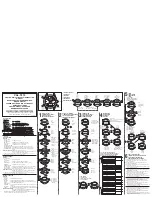
7.
TACHYMETER
TACH
YM
ET
ER
31
CHASE-DURER
P R O F E S S I O N A L
2 0 0 M E T E R S
60
40
20
10
30
50
T R A C K M A S T E R
10
8
2
4
6
9
3
12
6
9
3
12
6
TACH
YM
ET
ER
31
CHASE-DURER
P R O F E S S I O N A L
2 0 0 M E T E R S
60
40
20
10
30
50
T R A C K M A S T E R
10
8
2
4
6
9
3
12
6
9
3
12
6
slower, such as a bicycle, you must use a shorter
distance because the elapsed time must fall within
the
second range.
For this example, it took
36
seconds for a cyclist
to travel
1/4
of a mile. Reading the TACHYMETER
dial displays a speed of
100
mph, but the cyclist only
traveled
1/4
of a mile, so the actual speed would be
1/4
of that or an average speed of
25
mph over the
quarter mile.
Example No. 2
– To measuring something much
7.2
-
60
Using the TACHYMETER scale
The TACHYMETER dial is mainly used to compute an
average
speed after noting how long it takes to travel a
fixed distance (like one mile or one kilometer), but it can also be used to compute many other things.
The dial is a logarithmic scale that uses this formula to compute:
The chronograph second hand indicates 1/10, 1/4, 1/2, 1, 10, 100 or 1,000 etc. units (miles, objects, pounds
etc.). When stopped, the second hand points to the number on the TACHYMETER scale by which the number
of units (1, 10, 100 or 1,000 etc.) must be multiplied to obtain per-hour production rate or per-hour speed.
TACHYMETER DIAL = 3600 / Elapsed
Time In Seconds
seconds. The second hand, stopped as the mile
marker is passed, reads
120
on the TACHYMETER
scale. Average speed of the car is
120
x
1
, or
120
miles per hour.
Although decimal units (100 liters, 1 mile, 10
kilometers) make computing simple, in practice, the
TACHYMETER scale can be used to calculate
velocities and production rates from any number of
units.
Example No. 1
– A car covers one mile in
30
A
START/STOP
A
START/STOP































